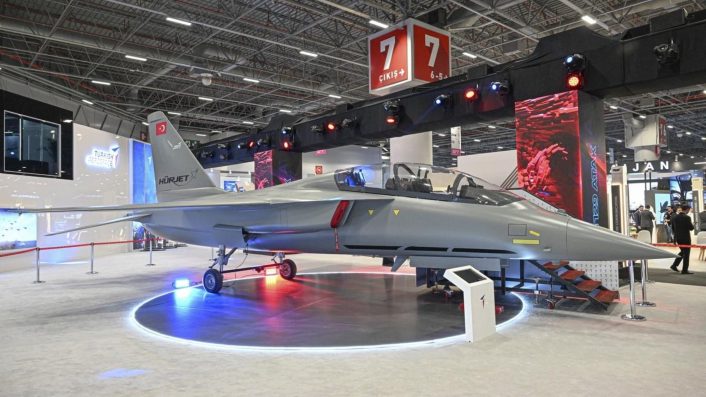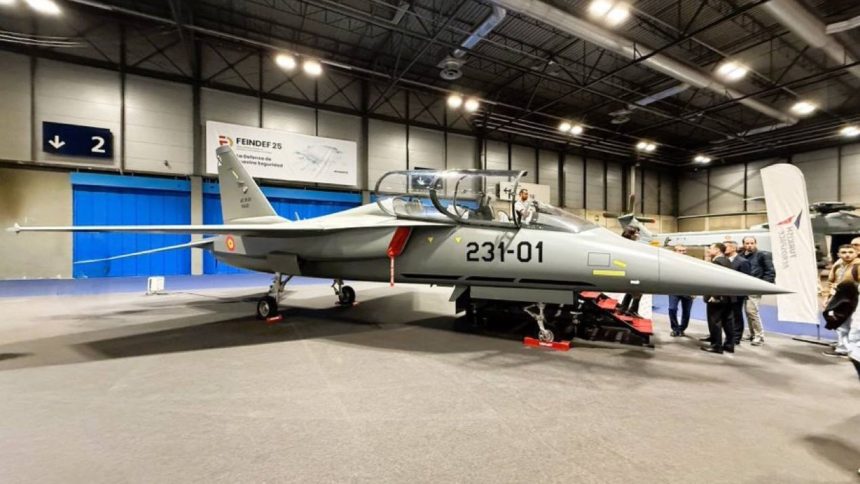The aircraft will be manufactured in Turkey and will undergo customization with Spanish subsystems and components at Airbus’ facilities in Spain.
Spain’s Council of Ministers approved on Sep. 24, 2025 the purchase of up to 45 Turkish Hürjet jet trainers, fulfilling a long-pending plan to replace its older 19 SF-5M Freedom Fighter jet trainers. This makes the Spanish Air and Space Force (SASF) the first foreign user of the Turkish aircraft, deliveries of which are expected to begin by 2028, with a service entry date of 2031.
The approval is mentioned in the latest Royal Decree 848/2025 amid a broader €3.68 billion defense push which includes 168 other fixed and rotary-wing aircraft. The number of Hürjets airframes is much higher than the 30 units agreed in the July pact between TAI (Turkish Aerospace Industries) and Airbus Defence and Space, inked on the sidelines of the 17th International Defense Industry Fair (IDEF 2025).
The pact also dealt with dividing the workshare between TAI/TUSAS and Airbus on the components suitable for the Hürjet’s Spanish variant, to be manufactured in Spain. Airbus represents the consortium of Spanish industries that would participate in the project.
Those discussions had also touched upon the infeasibility of activating a production line in Spain for the Hürjet for the small Spanish order, AviationWeek said at the time. This could also explain the increased order.
🇪🇦🇹🇷Spain has officially announced the purchase of 45 Hurjet fighter-trainer aircraft manufactured by Turkish TAI.
Initially, it was planned to buy 25-30 units, but in the end they settled on 45. The deal price is 1 billion euros.
The Hurjet itself is a new generation jet… pic.twitter.com/8nVSzEo8WV
— The War Action (@TheWarAction) September 24, 2025
As per the document, the aircraft will be manufactured at TAI’s facilities in Turkey, and undergo conversion/customization with Spanish systems at Airbus’ facilities.
Other aircraft approved in the plan include 18 C295s, 32 NH90 helicopters (version 3), 13 H135s, and 6 H175s, with a budget exceeding €10 billion. “This investment not only seeks to renew obsolete equipment but also to boost national industry and guarantee Spain’s strategic autonomy in defense matters,” said AvionRevue.
New government approval
Madrid’s Defense Minister Margarita Robles told the Senate Defense Committee a few months ago that the Hürjet is a “co-development” with Turkey, with subsequent airframes to be built/assembled in Spain’s Airbus facilities and fly with Spanish subsystems.
Beside developing a broader Integrated Training System (ITS) centered around the Hürjet to prepare the aircraft for Spanish use, Airbus and TAI had been working on finalizing the gradual “Spanishization” of the under-development aircraft, deciding what components would be built in Spain and would eventually go into the Spanish version of the aircraft.
🔵🇹🇷 HÜRJET heading to 🇪🇸Spain
🔸Up to 45 HÜRJET aircraft will be delivered to Spain. 🔸The aircraft will be produced at TUSAŞ facilities, and the customization process to meet the needs of the Spanish Air Force will be carried out at Airbus Defence and Space facilities. pic.twitter.com/m13uEKjBXt
— Defence Turk English (@Defence_Turk_EN) September 24, 2025
The latest document calls the broader Hürjet project the Advanced Integrated Flight Training System (ITS-C), adding it needs to be adapted in a “Spanish-inspired configuration developed by the national aeronautical and defense industry,” a machine translation of the Spanish text said. It would offer a new “combat training leap” for SASF pilots, further added the document.
“Deliveries are scheduled to begin in 2028, with a first set of aircraft available to begin familiarization and training on the platform for the 2029/2030 training course. In parallel, the Spanish configuration will be developed and integrated, with the first aircraft available starting in 2031. The entire ITS-C will be deployed at Talavera la Real Air Base (Badajoz), where the Fighter and Attack School is located, providing an operational life of at least 30 years,” the document added.

The project also has a Ground-Based Simulation System (GBSM) to allow synthetic training, while the ITS-C – as the document consistently refers to Hürjet – itself is also envisaged to be capable of performing “Red Air” roles. The document describes the jet capable of conducting “both training and light combat missions,” with a maximum speed of Mach 1.2 and an operating altitude of up to 45,000 feet. It is equipped with an F404-GE-102 engine that generates 17,000 pounds of thrust.
The Turkish Air Force plans to acquire at least 100 aircraft, and has so far ordered 17 Hürjet jet trainers, with a majority in the Block 0 configuration and the rest being Block 1s. A second prototype that flew last year also bores noticeable design changes, consistent with light attack roles.
Spain’s Hürjet journey
Spain evaluated the Hürjet prototype between July and August 2024 at Torrejon Air Base, near Madrid. This was followed by a December 2024 Memorandum of Understanding (MoU) between Turkey’s Presidency of Defense Industries (SSB) and the Spanish Ministry of Defense, formally selecting the Hürjet as the future trainer.
Then, in May 2025, TAI revealed the full-sized model of the Hürjet with SASF markings for display at the Feindef 2025 exhibition in Spain.
Strategic agreements for the export of HÜRJET to Spain have been signed with Airbus. ✈️
This development regarding the export of our HÜRJET Jet Trainer aims to strengthen Türkiye’s position in the European aviation market through its advanced technological competence. pic.twitter.com/C28UH8Kfhn
— Turkish Aerospace (@TUSAS_EN) July 24, 2025
Airtificial, a Spanish aerospace company based in Cádiz, is already involved in the Hurjet project, manufacturing active and passive flight control arms. The company announced on Apr. 3, 2024, that it signed a two-phase contract worth $2.8 million to manufacture these components for the Hurjet. During Feindef 2025 in June, agreements with Spanish companies like Aernnova, GMV, Indra, ITP Aero, Grupo Oesía, and Sener, were signed.
TUSAŞ ile Airbus arasında, HÜRJET için iş birliği anlaşması imzalandı! 🇹🇷🇪🇸
— HÜRJET’in İspanya yolculuğu için son durak… pic.twitter.com/F44jOBw5aP
— SavunmaSanayiST.com (@SavunmaSanayiST) July 24, 2025
The SASF’s Hürjets would be assigned to the Ala 23 (23rd Wing) at Talavera La Real Air Base. The F-5Ms are used to train pilots as part of the Fighter and Attack Phase to fly the Eurofighter Typhoons and EF-18M (Spain doesn’t use the F/A-18 Designation for its Hornets).









